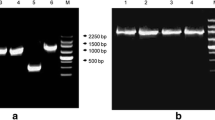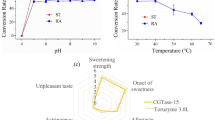Abstract
The use of the cyclodextrin glucanotransferase (CGTase) of the US132 strain, which is an effective anti-staling agent, has been hampered by its high cyclization activity. Since that random mutagenesis using error-prone PCR is nowadays a method of choice for enzymes engineering, we have optimized this method by adjusting manganese concentration in order to obtain a high percentage of active CGTase mutants. Therefore, the amplification of the gene encoding the US132 CGTase was performed using a MnCl2 concentration ranging between 0 and 0.5 mM. The finding showed that a manganese concentration of 0.04 mM allowed for 90 % of active mutants. A simple method to rapidly screen the obtained mutants was also developed. After the examination of a small library (of less than 1000 clones), the active mutant named MJ13 was selected for a significant decrease in the cyclization activity, thereby showing a remarkable change in the enzyme specificity towards starch dextrinizing. Sequence analysis showed that MJ13 is a triple mutant with two mutations in the catalytic domain (K47E and S382P) and one substitution in the starch binding domain (N655S).


Similar content being viewed by others
References
Ahn, H. J., Li, C., Cho, H. B., Park, S., Chang, P. S., & Kim, Y. W. (2015). Enzymatic synthesis of 3-O-α-maltosyl-l-ascorbate using an engineered cyclodextrin glucanotransferase. Food Chemistry, 169, 366–371.
Quin, M. B., & Schmidt-Dannert, C. (2011). Engineering of biocatalysts: from evolution to creation. ACS Catalysis, 1, 1017–1021.
Jemli, S., Ayadi-Zouari, D., Hlima, H. B., & Bejar, S. (2016). Biocatalysts: application and engineering for industrial purposes. Critical Reviews in Biotechnology, 36, 246–258.
Jung, S. T., Kang, T. H., & Kim, D. (2014). Engineering an aglycosylated Fc variant for enhanced FcγRI engagement and pH-dependent human FcRn binding. Biotechnology Bioprocess Engineering, 19, 780–789.
Shan, S., Zhang, Y., Ding, X., Hu, S., Sun, Y., Yu, Z., et al. (2011). A Cry1Ac toxin variant generated by directed evolution has enhanced toxicity against lepidopteran insects. Current Microbiology, 62, 358–365.
Foo, J. L., Ching, C. B., Chang, M. W., & Leong, S. S. (2012). The imminent role of protein engineering in synthetic biology. Biotechnology Advances, 30, 541–549.
Wen, F., Nair, N. U., & Zhao, H. (2009). Protein engineering in designing tailored enzymes and microorganisms for biofuels production. Current Opinion in Biotechnology, 20, 412–419.
Hou, L. (2009). Novel methods of genome shuffling in Saccharomyces cerevisiae. Biotechnology Letters, 31, 671–677.
Li, W., Chen, G., Gu, L., Zeng, W., & Liang, Z. (2014). Genome shuffling of Aspergillus niger for improving transglycosylation activity. Applied biochemistry and biotechnology, 172, 50–61.
Xu, B., Jin, Z., Wang, H., Jin, Q., Jin, X., & Cen, P. (2008). Evolution of Streptomyces pristinaespiralis for resistance and production of pristinamycin by genome shuffling. Applied microbiology and biotechnology, 80, 261–267.
Wang, T. W., Zhu, H., Ma, X. Y., Zhang, T., Ma, Y. S., & Wei, D. Z. (2006). Mutant library construction in directed molecular evolution: casting a wider net. Molecular Biotechnology, 34, 55–68.
Obruca, S., Snajdar, O., Svoboda, Z., & Marova, I. (2013). Application of random mutagenesis to enhance the production of polyhydroxyalkanoates by Cupriavidus necator H16 on waste frying oil. World Journal of Microbiology and Biotechnology, 29, 2417–2428.
Pfeifer, G. P., You, Y. H., & Besaratinia, A. (2005). Mutations induced by ultraviolet light. Mutation Research, 571, 19–31.
Sangkharak, K., & Prasertsan, P. (2013). The production of polyhydroxyalkanoate by Bacillus licheniformis using sequential mutagenesis and optimization. Biotechnology and bioprocess engineering, 18, 272–279.
McCullum, E. O., Williams, B. A., Zhang, J., & Chaput, J. C. (2010). Random mutagenesis by error-prone PCR. Methods in Molecular Biology, 634, 103–109.
Kotzia, G. A., & Labrou, N. E. (2009). Engineering thermal stability of l-asparaginase by in vitro directed evolution. FEBS Journal, 276, 1750–1761.
Minamoto, T., Wadab, E., & Shimizu, I. (2012). A new method for random mutagenesis by error-prone polymerase chain reaction using heavy water. Journal of Biotechnology, 157, 71–74.
Jemli, S., Ben-Ali, M., Ben-Hlima, H., Khemakhem, B., & Bejar, S. (2012). Mutations affecting the activity of the cyclodextrin glucanotransferase of Paenibacillus pabuli US132: insights into the low hydrolytic activity of cyclodextrin glucanotransferases. Biologia, 67, 636–643.
Leemhuis, H., Kragh, K. M., Dijkstra, B. W., & Dijkhuizen, L. (2003). Engineering cyclodextrin glycosyltransferase into a starch hydrolase with a high exo-specificity. Journal of Biotechnology, 103, 203–212.
Leemhuis, H., Rozeboom, H. J., Wilbrink, M., Euverink, G. J., Dijkstra, B. W., & Dijkhuizen, L. (2003). Conversion of cyclodextrin glycosyltransferase into a starch hydrolase by directed evolution: the role of alanine 230 in acceptor subsite +1. Biochemistry, 42, 7518–7526.
Shim, J. H., Kim, Y. W., Kim, T. J., Chae, H. Y., Park, J. H., Cha, H., et al. (2004). Improvement of cyclodextrin glucanotransferase as an antistaling enzyme by error-prone PCR. Protein Engineering, 17, 205–211.
Jemli, S., Ben Messaoud, E., Ben Mabrouk, S., & Bejar, S. (2008). The cyclodextrin glycosyltransferase of Paenibacillus pabuli US132 strain: molecular characterization and overproduction of the recombinant enzyme. Journal Biomed Biotechnology,. doi:10.1155/2008/692573.
Trevizano, L. M., Ventorim, R. Z., De Rezende, S. T., Junior, F. P. S., & Guimarães, V. M. (2012). Thermostability improvement of Orpinomyces sp. xylanase by directed evolution. Journal of Molecular Catalysis B: Enzymatic, 81, 12–18.
Cline, J., Braman, J. C., & Hogrefe, H. H. (1996). PCR fidelity of Pfu DNA polymerase and other thermostable DNA polymerases. Nucleic Acids Research, 24, 3546–3551.
Eckert, K. A., & Kunkel, T. A. (1991). DNA polymerase fidelity and the polymerase chain reaction. PCR Methods Appl., 1, 17–24.
Kelly, R. M., Leemhuis, H., & Dijkhuizen, L. (2007). Conversion of a cyclodextrin glucanotransferase into an alpha-amylase: assessment of directed evolution strategies. Biochemistry, 46, 11216–11222.
Klein, C., & Schulz, G. E. (1991). Structure of cyclodextrin glycosyltransferase refined at 2.0 Ǻ resolution. Journal of Molecular Biology, 217, 737–750.
Kelly, R. M., Dijkhuizen, L., & Leemhuis, H. (2009). The evolution of cyclodextrin glucanotransferase product specificity. Appl. Microbiol. Biot., 84, 119–133.
Uitdehaag, J. C., Kalk, K. H., van Der Veen, B. A., Dijkhuizen, L., & Dijkstra, B. W. (1999). The cyclization mechanism of cyclodextrin glycosyltransferase (CGTase) as revealed by a gamma-cyclodextrin-CGTase complex at 1.8 Ǻ resolution. Journal of Biological Chemistry, 274, 34868–34876.
Li, Z. F., Zhang, J. Y., Sun, Q., Wang, M., Gu, Z. B., Du, G. C., et al. (2009). Mutations of lysine 47 in cyclodextrin glycosyltransferase from Paenibacillus macerans enhance β-cyclodextrin specificity. Journal of Agriculture and Food Chemistry, 57, 8386–8391.
Han, R., Liu, L., Shin, H. D., Chen, R. R., Du, G., & Chen, J. (2013). Site-saturation engineering of lysine 47 in cyclodextrin glycosyltransferase from Paenibacillus macerans to enhance substrate specificity towards maltodextrin for enzymatic synthesis of 2-O-D-glucopyranosyl-L-ascorbic acid (AA-2G). Applied Microbiology and Biotechnology, 97, 5851–5860.
Acknowledgments
This research was supported by Grants-in-Aid for Scientific Research from the Ministry of High Education and Scientific Research of Tunisia (Contrat Programme CBS-LMB). We are thankful to Mrs. Salma Karray, an EFL teacher, for her valuable language polishing services.
Author information
Authors and Affiliations
Corresponding author
Additional information
Sonia Jemli and Mouna Jaoua have equally contributed to the present study.
Rights and permissions
About this article
Cite this article
Jemli, S., Jaoua, M. & Bejar, S. US132 Cyclodextrin Glucanotransferase Engineering by Random Mutagenesis for an Anti-Staling Purpose. Mol Biotechnol 58, 551–557 (2016). https://doi.org/10.1007/s12033-016-9952-z
Published:
Issue Date:
DOI: https://doi.org/10.1007/s12033-016-9952-z




